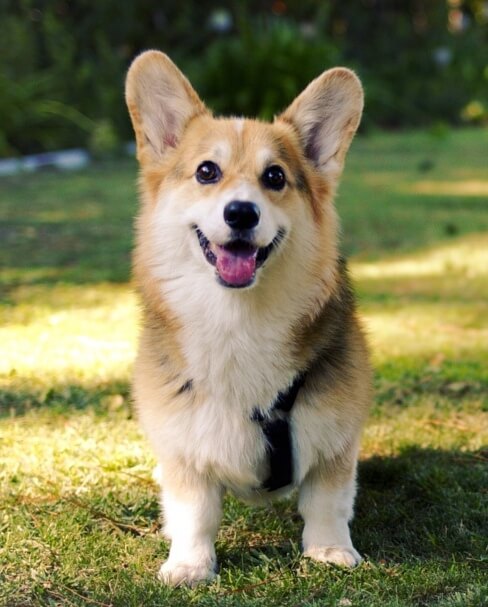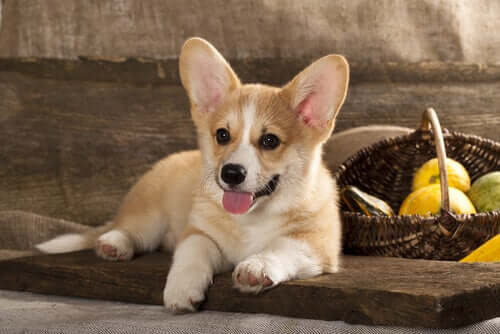Welsh Corgi: Meet This Cute Dog Breed


Written and verified by the lawyer Francisco María García
The Welsh Corgi, whose name means “dwarf dog” in Welsh, is a breed that originated in the United Kingdom. Some say it goes all the way back to the Visigoths so they’re actually Viking dogs. Of course, they’ve continued to adapt since then, and the animal we know today is different than the ones they had back in those times.
There are two types of Corgi:
- Welsh Corgi Pembroke, supposedly introduced by the Flemish, and usually a shepherd dog.
- The Welsh Corgi Cardigan, a housedog.
One of the differences between the two types of Corgi is that the Pembroke is larger than the Cardigan. They both mixed until breeders managed to accentuate their differences and officially establish the two types of Corgi in 1934.
Characteristics of the Welsh Corgi
Pembroke Welsh Corgi

- It can measure from 12 to about 15 inches high.
- Their weight ranges from 26 to 31 pounds.
- Their coat is medium length and slightly soft.
Cardigan Welsh Corgi
- They’re between 10 and 12 inches high.
- Their common weight is between 18 to 27 pounds.
- As for the coat, it’s usually very short and thick. (This is, aside from the height, one of the main differences between the two types of Corgi.)
Their hair color can vary and is multi-toned, coming in brown, black and white. You can also recognize them by their facial features which are similar to those of foxes –round eyes and an elongated snout. This is a small, robust dog, with short legs, pixie-like ears, and a short tail.
Even though the dog has a naturally short tail there are still breeders who cut it (through surgical procedures) at a young age. This is mainly for aesthetic reasons. However, in some countries, this procedure is now banned as it’s not required for their good health. Not only that, but it doesn’t allow the dog to express itself naturally.
Utility
These dogs are often used for driving cattle because their size is ideal to run around from one side to the other without being pushed or stepped on. The dog keeps the cattle in a group by nipping and nudging their ankles.
However, it’s now often acquired as a house dog due to its cute appearance and practical size. It’s even the favorite breed of the Queen Elizabeth of the UK.
Character
This dog is highly intelligent, extrovert, dynamic, lively, loyal, attentive, and hardworking. Even though they’re usually recommended for the job of herding on farms they’re also great with children and older folks. It’s for this reason that they’re well regarded as family pets.
As if that weren’t enough, Corgis are quite silent and quiet. That is, they don’t bark constantly like other breeds, so they’re great for people who live in condo buildings, and densely populated communities.
Behavior
This breed adapts to nearly any environment, from studio apartments to large farms. They don’t need a lot of exercising so a daily walk will suffice to allow them to release any accumulated energy they may have.
In addition, they don’t need continuous aesthetic care. It’s enough to brush them once a week and bathe them once in a while. Also, their instinct will keep anyone in their daily environment very well protected.
Health

The life expectancy of the Corgi is between 12 to 14 years. Obesity is one of the conditions that most affect this kind of dog because they’re a bit gluttonous and have a voracious appetite. This, in turn, leads to collateral damage such as all kinds of spinal injuries. They can’t hold excess weight due to their length, which makes them vulnerable to having back problems.
This dog’s diet must be a healthy one. It must have well-balanced rations and ingredients. A good amount of food for every meal should be about 6 to 11 ounces.
Other conditions that tend to afflict this dog breed are:
- Hip and retinal dysplasia
- Cataracts
- Hemophilia, a hereditary anomaly in the coagulation of blood
- Degenerative myopathy
- Osteoarthritis
- Dislocation of intraocular lenses
- Epilepsy
Ideal for the family
In general, this breed of dog is recommended as a house pet thanks to its great ability to adapt to its surroundings, as well as its keen intelligence and wonderful personality. They’re social dogs and know how to behave appropriately in most situations. This is why they’re good family dogs. If you get one it’ll be a very cheerful family member.
The Welsh Corgi, whose name means “dwarf dog” in Welsh, is a breed that originated in the United Kingdom. Some say it goes all the way back to the Visigoths so they’re actually Viking dogs. Of course, they’ve continued to adapt since then, and the animal we know today is different than the ones they had back in those times.
There are two types of Corgi:
- Welsh Corgi Pembroke, supposedly introduced by the Flemish, and usually a shepherd dog.
- The Welsh Corgi Cardigan, a housedog.
One of the differences between the two types of Corgi is that the Pembroke is larger than the Cardigan. They both mixed until breeders managed to accentuate their differences and officially establish the two types of Corgi in 1934.
Characteristics of the Welsh Corgi
Pembroke Welsh Corgi

- It can measure from 12 to about 15 inches high.
- Their weight ranges from 26 to 31 pounds.
- Their coat is medium length and slightly soft.
Cardigan Welsh Corgi
- They’re between 10 and 12 inches high.
- Their common weight is between 18 to 27 pounds.
- As for the coat, it’s usually very short and thick. (This is, aside from the height, one of the main differences between the two types of Corgi.)
Their hair color can vary and is multi-toned, coming in brown, black and white. You can also recognize them by their facial features which are similar to those of foxes –round eyes and an elongated snout. This is a small, robust dog, with short legs, pixie-like ears, and a short tail.
Even though the dog has a naturally short tail there are still breeders who cut it (through surgical procedures) at a young age. This is mainly for aesthetic reasons. However, in some countries, this procedure is now banned as it’s not required for their good health. Not only that, but it doesn’t allow the dog to express itself naturally.
Utility
These dogs are often used for driving cattle because their size is ideal to run around from one side to the other without being pushed or stepped on. The dog keeps the cattle in a group by nipping and nudging their ankles.
However, it’s now often acquired as a house dog due to its cute appearance and practical size. It’s even the favorite breed of the Queen Elizabeth of the UK.
Character
This dog is highly intelligent, extrovert, dynamic, lively, loyal, attentive, and hardworking. Even though they’re usually recommended for the job of herding on farms they’re also great with children and older folks. It’s for this reason that they’re well regarded as family pets.
As if that weren’t enough, Corgis are quite silent and quiet. That is, they don’t bark constantly like other breeds, so they’re great for people who live in condo buildings, and densely populated communities.
Behavior
This breed adapts to nearly any environment, from studio apartments to large farms. They don’t need a lot of exercising so a daily walk will suffice to allow them to release any accumulated energy they may have.
In addition, they don’t need continuous aesthetic care. It’s enough to brush them once a week and bathe them once in a while. Also, their instinct will keep anyone in their daily environment very well protected.
Health

The life expectancy of the Corgi is between 12 to 14 years. Obesity is one of the conditions that most affect this kind of dog because they’re a bit gluttonous and have a voracious appetite. This, in turn, leads to collateral damage such as all kinds of spinal injuries. They can’t hold excess weight due to their length, which makes them vulnerable to having back problems.
This dog’s diet must be a healthy one. It must have well-balanced rations and ingredients. A good amount of food for every meal should be about 6 to 11 ounces.
Other conditions that tend to afflict this dog breed are:
- Hip and retinal dysplasia
- Cataracts
- Hemophilia, a hereditary anomaly in the coagulation of blood
- Degenerative myopathy
- Osteoarthritis
- Dislocation of intraocular lenses
- Epilepsy
Ideal for the family
In general, this breed of dog is recommended as a house pet thanks to its great ability to adapt to its surroundings, as well as its keen intelligence and wonderful personality. They’re social dogs and know how to behave appropriately in most situations. This is why they’re good family dogs. If you get one it’ll be a very cheerful family member.
This text is provided for informational purposes only and does not replace consultation with a professional. If in doubt, consult your specialist.








